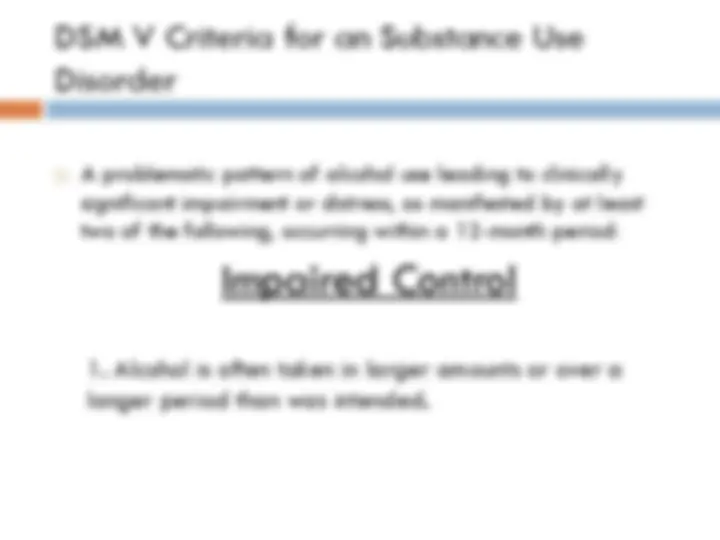






























Study with the several resources on Docsity

Earn points by helping other students or get them with a premium plan


Prepare for your exams
Study with the several resources on Docsity

Earn points to download
Earn points by helping other students or get them with a premium plan
Community
Ask the community for help and clear up your study doubts
Discover the best universities in your country according to Docsity users
Free resources
Download our free guides on studying techniques, anxiety management strategies, and thesis advice from Docsity tutors
Episodic excessive drinking, habitual excessive drinking, and alcohol addiction. □ In DSM II, drug dependence was expanded to include subcategories.
Typology: Lecture notes
1 / 36

This page cannot be seen from the preview
Don't miss anything!





























Ronald W. Kanwischer LCPC, CADC Professor Emeritus Department of Psychiatry SIU School of Medicine
I have no financial relationships to disclose with regard to this presentation. This talk is free of commercial bias.
“An Odious Disease” Dr. Benjamin Rush, 1784
The word “alcohol” didn’t come into use until the eighteenth century and was used to designate the intoxicating ingredient in liquor.
“alcoholism” was first used in 1849 by Dr. Magnus Huss to describe chronic intoxication with physical and social pathology
A century later the word “alcoholic” was common in the United States
Slang and Professional Language used to describe a problem with alcohol and the problem drinker
Drunkard Inebriety/Inebriates Tipplers Intemperance Dipsomania (thirst frenzy) Drunkard Barrel fever Alcoholism
Jellinek’s Disease Problem Drinker Alcoholic Problematic alcohol use Deviant drinker Excessive drinking Addiction (from the Latin, “to adore”, to surrender oneself)
In the first edition of the DSM in the 1950’s, alcoholism and drug addiction were grouped with “sociopathic personality disturbances”
Signs and symptoms were not described, but instead the idea that addiction came from an “underlying brain or personality disorder”.
In DSM II (1968) added “subtypes” of alcoholism.
Episodic excessive drinking, habitual excessive drinking, and alcohol addiction.
In DSM II, drug dependence was expanded to include subcategories. Specific drug classes and physiological signs of dependence (withdrawal and tolerance)
DSM III, cont.
The idea of a public health model was introduced to explain addiction. The dependence category required either tolerance or withdrawal (or both) to be present. Abuse was the presence of drug related problems in the absence of physiological symptoms.
Reflected a growing concept that addiction really involved a broader behavioral syndrome and was not only defined by physical symptomology. “Abuse” remained as a category for people who never met the “dependence” diagnosis.
DSM IV-R cont. Dependence has to meet three or more of seven physiological or behavioral criteria. (this left some diagnostic orphans, none of the criteria for abuse and only one or two in the dependence category) DSM V Factor analyses found that the abuse and dependence criteria actually loaded on a single factor and are interrelated with each other. The term “addiction” is not applied as a diagnostic term, the more neutral term, “substance use disorder” is used to describe the wide range of the disorder.
Addiction is a primary, chronic disease of brain reward, motivation, memory and related circuitry. Dysfunction in these circuits leads to characteristic biological, psychological, social and spiritual manifestations. This is reflected in an individual pathologically pursuing reward and/or relief by substance use and other behaviors.
The DSM IV “recurrent substance related legal problems” is switched out with “craving, or a strong desire or urge to use a substance”.
A new criteria threshold is in place to establish a substance use disorder…it is now “two or more” criteria. Past abuse was one or more or three or more for dependence.
Cannabis withdrawal and caffeine withdrawal are new disorders.
The DSM IV specifier for “physiological subtype” is eliminated.
The DSM IV diagnosis of “polysubstance dependence” is eliminated.
Additional Specifiers:
“in a controlled environment”, “on maintenance therapy”
A problematic pattern of alcohol use leading to clinically significant impairment or distress, as manifested by at least two of the following, occurring within a 12-month period: